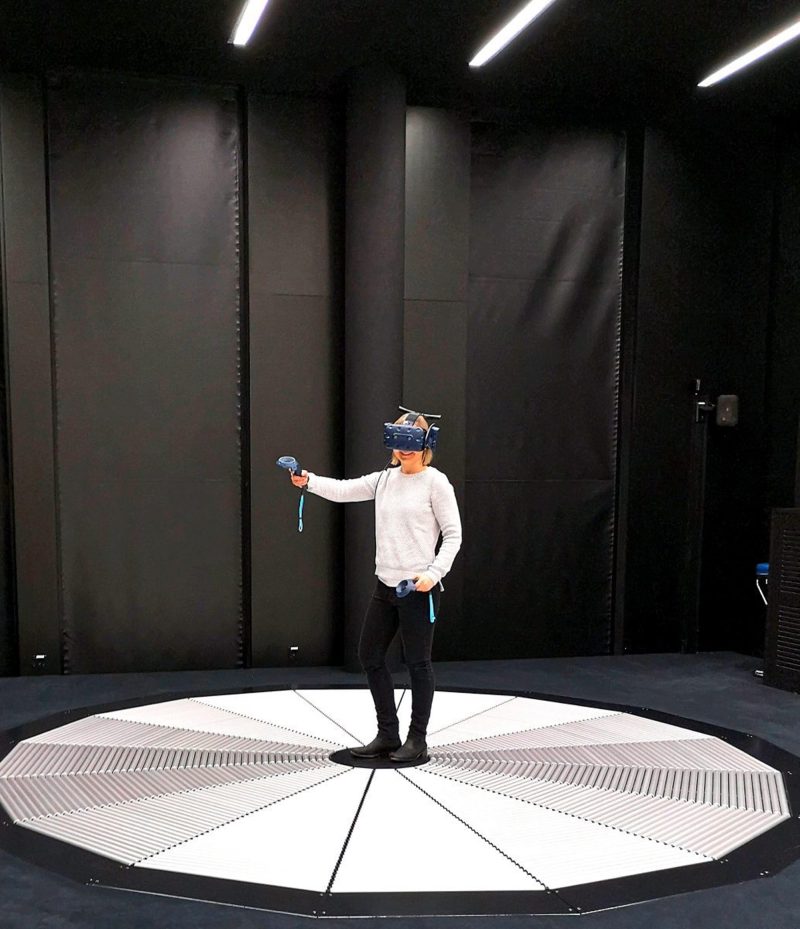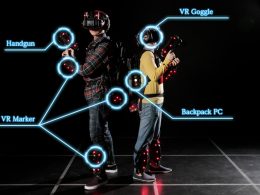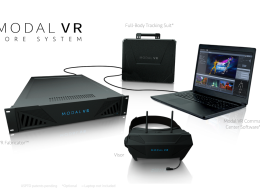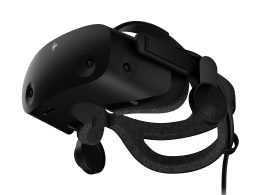A laboratory for virtual reality applications was recently opened in Krems, Austria. An interactive platform there invites visitors to take VR walks.
The Omnideck is the highlight of the new virtual reality (VR) research lab eVRyLab at IMC University of Applied Sciences Krems. It is an interactive platform for VR walks embedded in the floor and allows users to move through VR environments in a particularly fluid and thus realistic way.
The installation measures a good four metres in diameter and is divided into 16 wedge-shaped segments. Each segment consists of parallel metal rollers that can be moved by a conveyor belt underneath. The centre of the deck is a round, immobile area from which one starts walking. Depending on which direction and how fast one moves, the corresponding rollers are activated at the appropriate pace. This has the effect that the user never crosses the edge of the platform, but - like on a fitness treadmill - always stays in the same place. If the user stops, the rollers transport him or her back to the centre again, hardly noticeable. Two sensors outside the Omnideck record the exact position of the user on the platform with millimetre precision. From this position data, the control computer calculates the virtual position of the user in the simulation and displays the appropriate scene on the glasses.
A special feature is that the VR goggles used are not wired, but communicate with the control computer via radio. The absence of a cable makes the experience even more realistic. In addition, the notorious "motion sickness" that sometimes afflicts users of VR applications due to the fluid movements made possible by the Omnideck is said to be largely eliminated.
https://www.youtube.com/watch?v=fwlhZljqeR0&feature=youtu.be
Mobile people scanner helps to create rooms
There is no restriction on the choice of virtual worlds you enter. There are no prefabricated VR rooms. You can create your own. In order to be able to integrate real rooms and objects, the eVRyLab has a laser scanner, a small hand scanner and a mobile people scanner. The latter is a round cabin with 93 cameras, each with eight megapixel resolution.
The Omnideck cost around 150,000 euros. There are currently only five in use in Europe. The acquisition is part of the Scan2VR project funded by the province of Lower Austria, which aims to digitise objects, people, rooms and even large-scale environments and prepare them for VR inspections.
Playing desired
"We plan to work out new solutions together with Kunstmeile Krems on how to present art," explains Michael Reiner, professor at the Department of Business at IMC University of Applied Sciences Krems and head of the new VR lab. "You can scan a room and then, for example, virtually place different exhibits in it to test the effect." A task that is as appealing as it is challenging, given that the Kunstmeile includes such architecturally diverse buildings as the Landesgalerie, the Kunsthalle and the Dominikanerkirche. Isn't there a danger of leaving the path of serious research and slipping into playfulness in the face of such high-quality hardware? On the contrary, says Reiner. "I even encourage my team to try out games," he says. "Because that allows us to test the possibilities of the Omnideck very well." Of course, the infrastructure of the eVRyLab will also be used in teaching at the UAS. And guided tours for school classes are also planned, where young people can be introduced to the potential of the technology in a vivid way. After all, as soon as you get used to the peculiarities of the Omnideck, it starts to be really fun.
Source: derstandard









